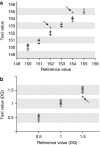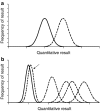A standardized framework for the validation and verification of clinical molecular genetic tests
- PMID: 20664632
- PMCID: PMC3002854
- DOI: 10.1038/ejhg.2010.101
A standardized framework for the validation and verification of clinical molecular genetic tests
Abstract
The validation and verification of laboratory methods and procedures before their use in clinical testing is essential for providing a safe and useful service to clinicians and patients. This paper outlines the principles of validation and verification in the context of clinical human molecular genetic testing. We describe implementation processes, types of tests and their key validation components, and suggest some relevant statistical approaches that can be used by individual laboratories to ensure that tests are conducted to defined standards.
Figures








References
-
- Haddow JE, Palomaki GE.ACCE: a model process for evaluating data on emerging genetic testsin Khoury M, Little J, Burke W (eds): Human Genome Epidemiology: A Scientific Foundation for Using Genetic Information to Improve Health and Prevent Disease Oxford University Press: New York; 2003217–233.
-
- International Organization for Standardization Medical laboratories – Particular requirements for quality and competenceISO 15189:2007
-
- International Organization for Standardization General requirements for the competence of testing and calibration laboratoriesISO/IEC 17025:2005
-
- EuroGentest, EU Contract No.: FP6-512148 , http://www.eurogentest.org .
-
- Jennings L, Van Deerlin VM, Gulley ML. Recommended principles and practices for validating clinical molecular pathology tests. Arch Pathol Lab Med. 2009;133:743–755. - PubMed
Publication types
MeSH terms
Grants and funding
LinkOut - more resources
Full Text Sources
Other Literature Sources
Medical
Molecular Biology Databases

